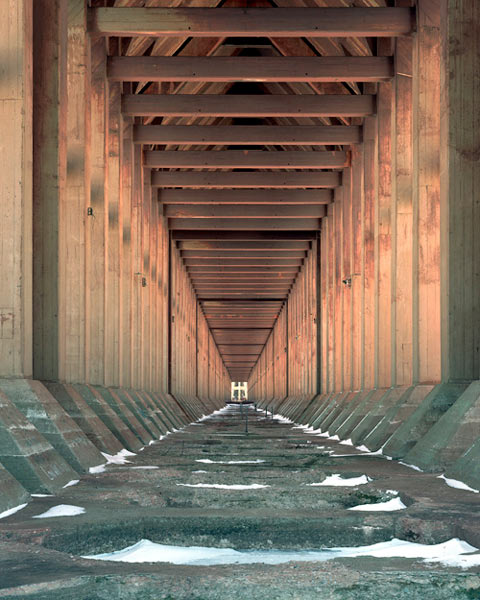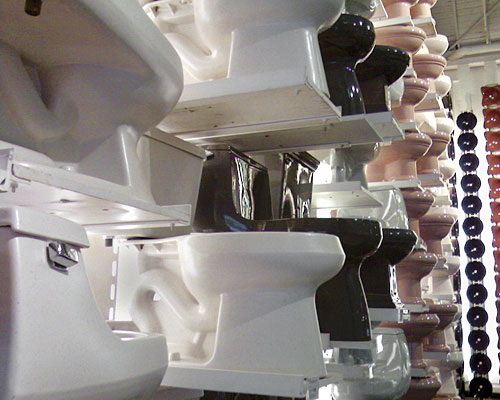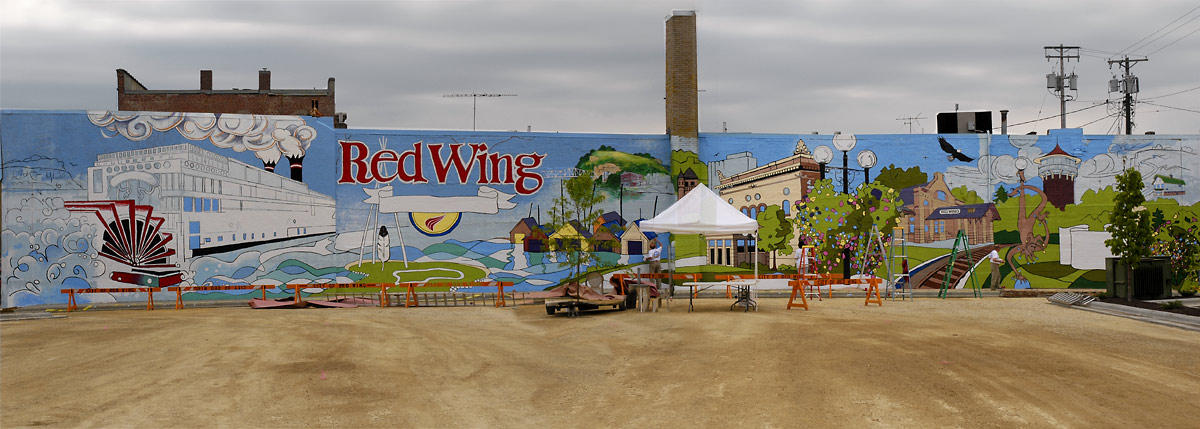Sunday, April 13, 2008, 03:08 PM
I recently completed a project for the Historic American Engineering Record (HAER) documenting the old Soo Line Railroad ore docks in Ashland Wisconsin. Built in 1915, the 1800 foot long 80 foot high dock has not been used since 1965 and is literaly falling down into Lake Superior. It is the last of five docks that at one time served northern Wisconsin's ore industry. Although controversial, the dock could not be saved.

But, since the dock is deemed an important historic structure, the current owner was required to have the structure documented before demolition could begin. The documentary photographs needed to meet Library of Congress archival standards, requiring 4X5 black and white film and making traditional (not digital) prints. Also since parts of the dock are only accessible by crossing the ice, the photographs had to be taken in the winter. I lucked out and had a perfect, almost balmy, 30 degree day.
I admit that I normally work in color, but the truth is that black and white negatives are still the most archival medium. However I could not help but make a few color images as well. The inside of the dock was like a cathedral. What a wonderful space!
Click on the image to see a larger version of the dock interior from the water-end. Photo Copyright 2008 by David Husom.
The Historic American Engineering Record (HAER) collection is a part of the Prints and Photographs Division of the Library of Congress. Eventually the photos will be available online for researchers:
memory.loc.gov/ammem/collections/habs_haer
[ 1 comment ] ( 71 views ) | permalink
Friday, January 25, 2008, 12:16 PM
We had a chance to go to Sheboygan Wisconsin to the John Michael Kohler Art Center to see the Sublime Spaces & Visionary Worlds: Artist Environments exhibit. I had been in a show at the Kohler once, but never made it there to see the galleries. What a treat! When so much of the art world is tied to money, ego, fame, prestige and worse, it is easy to forget that what it should be about is the experience of making and seeing. Here is an exhibit of artists who were not gallery artists, grant recipients, art fair participants, folk artists, outsider artists, or tenured faculty. Instead they were people who worked with a passion just for the love of making personal art and surrounded their lives with it. The show includes some well known names like Sabato (Simon) Rodia creator of the Watts Towers, Fred Smith of the Wisconsin Concrete Park, known to anyone who had ventured into northern Wisconsin and passed through Phillips, and Tom Every who has built the Forevertron in North Freedom, WI (which I have yet to see in person, but it is on my list!). But there are so many others that I was completely unaware of.
Historically the show begins with Levi Fisher Ames who around the turn of the 20th Century traveled the back roads of Wisconsin with trunk-loads of carved wooden animals, trinkets and an art museum of wonder. Loy Bowlin of McComb, Mississippi billed himself as the “original rhinestone cowboy” and decorated every square inch of his modest house with glitter and rhinestones. It was a four year process to dismantle the house, restore it, and re-assemble it within the Kohler galleries. Nek Chand has filled 10 acres of rolling hills near his home in India with marvelous life size sculptures. Emery Blagdon, built the Healing Machine to redirect energy through hundreds of hanging sculptures.
Milwaukee artist Eugene Von Bruenchenhein worked with chicken bone sculptures, but more importantly did paintings and photographs that were often surprisingly ahead of their time. Long before Robert Heineken did his “found negatives” by contacting magazine pages, here was Von Bruenchenhein playing with the double exposure of both sides of the page printing through. Mary Nohl, an art school graduate, filled her cabin-sized house and Lake Michigan shoreline yard with her creations. Vietnam War vet Dr. Charles Smith built the African American Heritage Museum and Black Veteran’s Archives in the suburbs of Chicago so that the people of the neighborhood would not have to go to a museum to see art. What is amazing about the show was how it is able to capture the environmental aspects of the work even removed from their original locations.
What I have always found fascinating is how many of these environmental artists are in the Minnesota - Wisconsin area. Although not in the exhibit, the catalog for the show does include Cochrane Wisconsin visionary artist Herman Rusch, who I met when I was a student (I am clueless now as to why I did not photograph him and his work that day). The catalog does offer a good answer to the question as to why all this concrete art ended up here: the Dickyville Grotto built by Father Mathias Werneru in the 1920’s. Even Simon Rodia is believed to have been influenced by it when he worked for a time as a construction worker on the project. The Grotto is wonderful and well worth a visit—it is located near the Wisconsin, Illinois and Iowa border. But for some reason I had ignored its influence on small town bathtub grottoes (a Midwestern phenomena where a tub is sunk in the ground a stature of the Virgin Mary or a Saint are placed in it) and the life-long projects of people like Rusch, Smith, James Tellen and Minnesotan Carl Peterson and Wisconsinites Paul and Matilda Wegner until I read the catalog.
I recall over the years seeing the work of lesser known concrete artists, including a great one in the St. Cloud area. There was a little house in the back of the lot surrounded by tall bushes near where I grew up in Minneapolis. The kids in the neighborhood discovered that behind those big bushes was a virtual fantasy garden of ponds, bridges and a small castle. One day, when I was in high school, I walked down the alley and there behind the garage was a pile of busted-up concrete. Someone had removed the secret garden of art.

Carl Peterson transformed his St. James Minnesota garden with concrete, rock and shell structures. Some are on permanent display outside of the Art Center. (Cell Phone Photo of JMKAC Courtyard by David Husom)

Also at the Kohler Art Center are the best bathrooms you have ever seen anywhere. Each was designed by an artist. (Cell Phone Photo of Mens Room at the JMKAC by David Husom)
Parts of the show are held over see: www.jmkac.org/SublimeClosingDates
For more on Visionary Artist Environments see: rarevisionsroadtrip.com

And speaking of Kohler, the Kohler company has ties to the Art Center but they have their own museum and showroom in the nearby town of Kohler. (Cell Phone Photo of Kohler Design Center by David Husom) Click on image to see larger version.
[ add comment ] | permalink
Sunday, May 13, 2007, 01:50 PM
Gary Stone of Red Wing Minnesota's Hobgoblin Music and Stoney End Harps thought the town needed something special for its Sesquicentennial and contacted well known local artist Dan Wiemer about creating a work of art that would showcase Red Wing. With the support of the Red Wing Art Association, area merchants donated paint and supplies for the mural. The City of Red Wing also is remaking the parking lot in front of it. As you can see from the photograph below the mural is still a work in progress (click on the image to see a larger version). But it is ahead of schedule and should be done soon. If you enter Red Wing from Wisconsin 63 you can't miss it. It will be straight ahead on the corner of 3rd and Plum.
Sorry to say I have been too busy to lend a hand painting but I have worked with Gary and Dan from the begining on helping to lay out and scan the original art work. Getting a painting to fit a wall was much harder than I thought it would be!

Check out our new Technorati Profile
[ add comment ] | permalink
Sunday, February 18, 2007, 12:17 PM
I really enjoy meeting young journalists and eagerly agreed to do a session at the Best of the Midwest College Newspaper Conference again this year. Thanks again for the chance to speak to you all. If you were there here are some of the links I mentioned for good information on blogs:Online Journalism Review's Blog Software Comparison Chart
cyberjournalist.net/
Nielsen Blogpluse
Electronic Frontier Foundation Legal Guide for Bloggers
Poynter on Online Ethics
Here are Corey Anderson's Blogs at City Pages
I know the Twin Cities can seem a bit dead sometimes but leaving the convention hotel I found the streets of Minneapolis deserted - on a Saturday Afternoon. (Cell Phone Photo):

[ add comment ] | permalink
Thursday, February 15, 2007, 05:23 PM
 I was way too late to see or hear Bob Dylan in his Minneapolis days hanging out in the Dinkytown neighborhood and working on the campus newspaper in Murphy Hall (where I now teach and write this posting). But when I was a high school student I had made a pilgrimage to the 10:00 Scholar in Dinkytown to see the spot where Dylan began his career. The Scholar had burned down a few years earlier, but its charred facade remained and its sign was still readable. By the time I started college a few years later, Dylan was a household name and where the Scholar had been there was a Burger King under construction. Burger King is still there frying burgers, and I am still a Dylan fan having replaced all my early Dylan LP's with CD's.
I was way too late to see or hear Bob Dylan in his Minneapolis days hanging out in the Dinkytown neighborhood and working on the campus newspaper in Murphy Hall (where I now teach and write this posting). But when I was a high school student I had made a pilgrimage to the 10:00 Scholar in Dinkytown to see the spot where Dylan began his career. The Scholar had burned down a few years earlier, but its charred facade remained and its sign was still readable. By the time I started college a few years later, Dylan was a household name and where the Scholar had been there was a Burger King under construction. Burger King is still there frying burgers, and I am still a Dylan fan having replaced all my early Dylan LP's with CD's. I have to admit when I first heard that an art museum was doing a Bob Dylan exhibit I had a few doubts. How could anything visual compare to the powerful poetry for Dylan's music? But the University of Minnesota's Frederick R. Weisman Art Museum exhibit Bob Dylan's American Journey 1956-1966 proved me wrong! What a great exhibition.
The visuals are strong (Woody Guthrie's tee-shirt from the institution he spent his final days in is downright spooky). The vintage photographs are great. And of course the music, not just from Dylan but from many of his contemporaries and mentors, is wonderful. Organized by the Experience Music Project (EMP) in Seattle with Bob Dylan’s cooperation, the show is up until April 29th 2007. Give yourself a LOT of time to look, listen and think about this American master.
Cellphone photo by David Husom
Bob Dylan at the Weisman Information
[ add comment ] | permalink
Back Next






